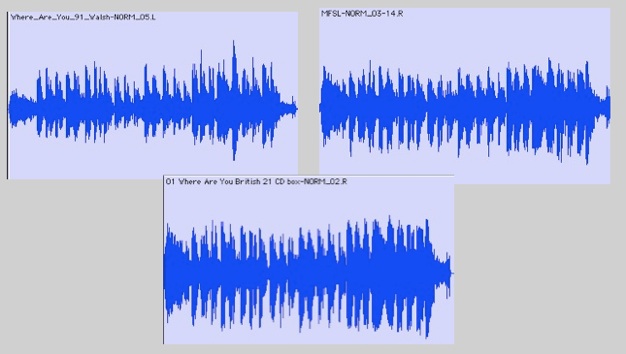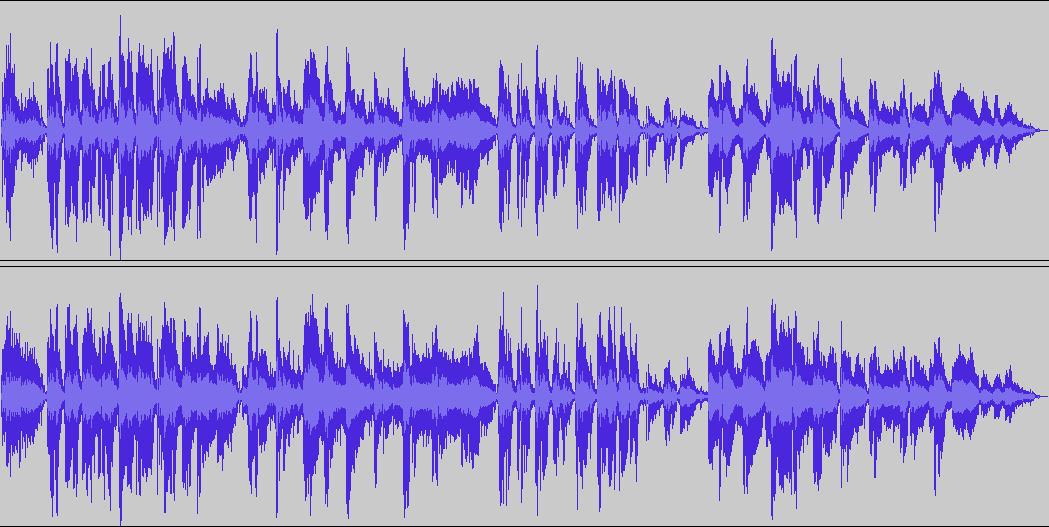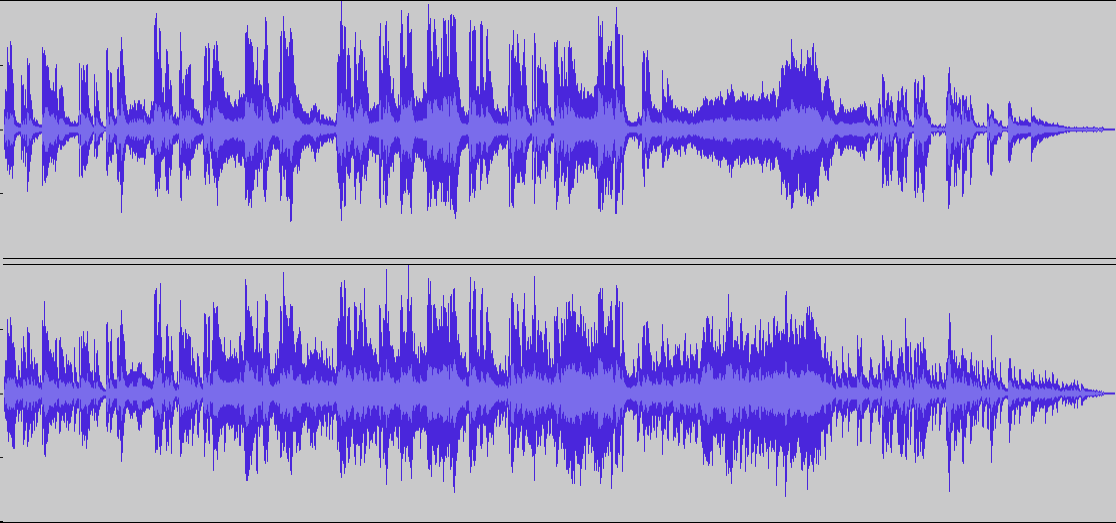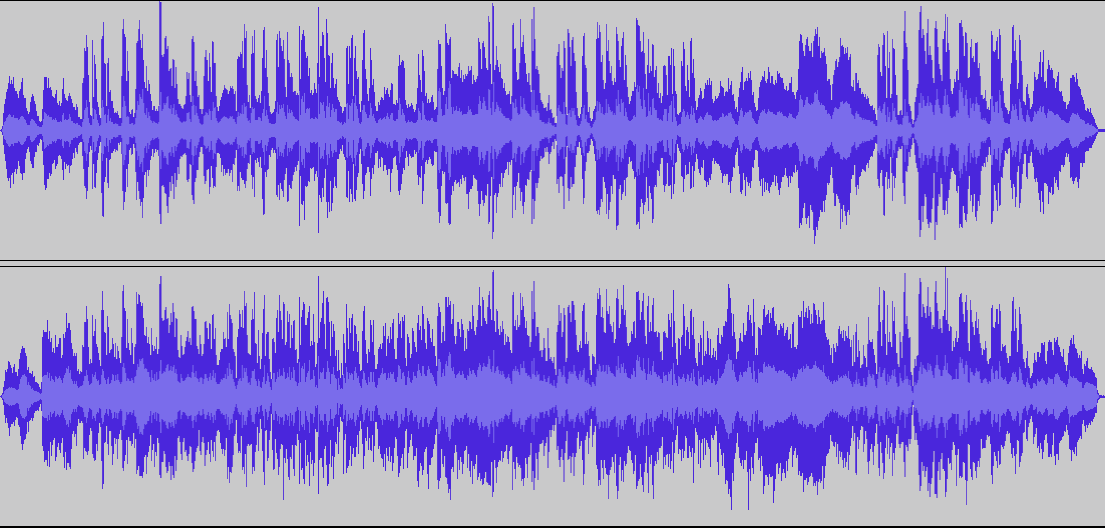Point of No Return - 1962

That’s three different waveforms of the same track and channel of the Where Are You title track. Notice how the upper right form is almost identical to the bottom one? Those both use the original mix (MFSL stereo LP and UK 1998 CD). Now, look at the upper left waveform. It has a totally different contour to it, and it’s from the Capitol CD that was remixed from scratch by Larry Walsh. Mr. Walsh’s mix was significantly more dynamic than the original. (Kudos to Mr. Walsh!)
Now.... Remember this little ditty from the Nice ‘n’ Easy pages?
Remember this little ditty from the Where Are You pages?

I have been in many acoustically-excellent concert halls, and even stood in a few echo chambers in recording studios, and they all shared one common element: Because I have two ears, I always hear the reverb in stereo. It sounds yummy. On the original stereo mixes of No One Cares and (especially on) Nice ‘n’ Easy, the reverb on Sinatra’s vocal is MONO! What the heck? [....] Listen to these two segments (original mix with “clumpy” mono reverb first, followed by the Walsh remix with stereo reverb) and try to focus on the reverb that you hear coming off the vocal. [....]The original mix that starts the samples has vocal reverb clearly placed directly “behind” the vocal, not diffused off to the sides. Listen, original first, then Walsh remix on both samples:
Sample #1: ButWhyStereoMFSLCD-Walsh.mp3 SAMPLE #2: HowGladStereoSamples.mp3
[....] The original mix used TWO reverb chambers, one in mono for the vocal, and one in stereo for the orchestra, while the Walsh apparently used one in stereo for everything at once.
As Time Goes By - click text below to hear clips from any of the four available masterings, Walsh 1987, UK 1998, Norberg 1998, and MFSL 2013:
AsTimeGoesWalshClip-GAIN_01.wav AsTimeGoesUK98Clip-GAIN_01.wav AsNorbergGoesClip-NORM_01.wav AsTimeClipMFSL-GAIN_01.wav
Samples with transitions: Norberg-Walsh-Norberg-Walsh.wav Walsh-UK98-Walsh-UK98.wav AsTimeMFSLCD-UK98.wav AsTime MFSLCD-Walsh.wav
Tape dropout: You may have noticed that there is some audible tape damage at “man must have his mate.” Here is a montage of snippets of just that vocal phrase, in this order: 1.) Original D5 stereo pressing; 2.) 1984 UK Dell pressing; 3.) 1987 Walsh CD; 4.) 1998 Norberg CD; and 5.) 1998 UK CD. Click GlitchD5-Dell-Walsh-Norberg-UK98.mp3 to listen. I think this may be (another well-done) tape splice that has fallen apart and been re-spliced. It’s interesting that the D5, 1984 Dell LP, and 1998 Dell CD have no audible damage, while the 1987 Walsh and 1998 Norberg do. Maybe the 1998 UK CD used the 1984 UK LP digital tape, “pre-damage?”
Why am I bringing up this old stuff about other albums?
1. The waveforms for the 1991 Larry Walsh CD are extremely similar to the waveforms for the original mix, as it appears on the digitally mastered Alan Dell LP. Have a look:

-
2.The vocal reverb on the Larry Walsh CD is mono, which is not typical for the Walsh-remixed albums on CD.
-
3.All of the edits, quirks, defects, etc., that are in the original mix are also on the Larry Walsh CD.
Conclusion? Surprisingly, The 1987 CD, mastered by Larry Walsh, is not a remix. Neither are the Norberg or UK remasters. Unless I’m mistaken, this is the only Capitol stereo Sinatra album to not be remixed for compact disc. To my knowledge, two songs have received remixes for CD release, those being: 1.) “I’ll Be Seeing You,” remixed by Ron Furmanek and Larry Walsh for The Capitol Years 3-CD set, and then remixed again by Dave McEowen for Romance: Songs from the Heart; and 2.) “As Time Goes By,” from the same Romance CD. Full-length CDs? All original mixes, yet each quite different sounding than the others. Let’s compare.
The clips available on this page align with the free samples available via iTunes, linked above and below. Click on “VIEW,” then on “View in iTunes.”
CD RELEASES - Updated Dec. 1, 2013
(Thanks to SH.TV members Chris C, OldCoder, MMM, and Bob F for clips and assistance.)
All clips align with the free, readily-available clips used on iTunes. To access the 90-second clips, click “VIEW” in the window at left, then click “View in iTunes.”
These Foolish Things - click text below to hear clips from any of the four available CD masterings:
TheseFoolishWalshClip-GAIN_01-04.wav These Foolish Things - 1998UK.wav
These Foolish Things - Norberg.wav TheseFoolishMFSLCDClip-GAIN_01.wav
Samples with transitions: Walsh to Norberg.wav UK98 to Walsh87.wav
DYNAMICS
For some unknown reason, the MFSL CD appears be be sorely lacking in terms of dynamic range, a fact that seems all the more strange when one considers that the recent mono MFSL CD and LP releases of Where Are You are demonstrably the most-dynamic releases of that title, and by a considerable margin. How unremarkable are the MFSL dynamics?
“As Time Goes By” - MFSL CD = -16.7 dB RMS; Dell LP = -19.1 dB RMS
“These Foolish Things” - MFSL CD = -16.6 dB RMS; Dell LP = -19.6 dB RMS
(All clips peak normalized, “apples to apples”)
Anytime we get into that 3dB range, the difference is clearly audible, not some rogue audio subtlety. On the well-known DR Scale, As Time Goes By scores a 10 on the MFSL CD, 11 on the Walsh CD, and 12 on the UK CD and the Dell LP. These Foolish Things scores a 10 on the MFSL CD, 11 on the Walsh, 12 on the UK CD, and 13 on the Dell LP.
At right, waveforms for As Time Goes By (top) and These Foolish Things (bottom set) are visible for the Dell LP and the new MFSL CD.
Lest somebody think the dynamic differences are caused by some sort of drastic EQ manipulations, here is a clip that starts with the MFSL CD then transitions to the 1984 Dell LP: AsTimeMFSLCD-Dell84.wav
Tonally, the two releases are very similar.


•1984 UK “Dell” LP -------> Original D5 LP: AsTimeGoesDell-D5.aif
•D5 LP -----> 1984 UK “Dell” LP: TheseFoolishD5-Dell.aif
•2014 MFSL LP -----> 1984 Dutch “Dell” DMM LP: Foolish MFSLLP-DMM.wav
•1984 Dutch “Dell” DMM LP -----> 2014 MFSL LP: TimeDMM-MFSLLP.wav
You will notice that there is some tape damage apparent on the MFSL portion of that last clip. (The same damage appears on the MFSL SACD.) Here is a clip that starts with the MFSL LP, then repeats the same section from the Dell LP, which does not exhibit the damage: WomanNeedsDefectMFSL-DMM.wav

LET’S GO HEAD-TO-HEAD!

How about the hum?
Oddly, there is some obvious and bothersome hum on tracks one and two of the MFSL CD. To illustrate, here is a clip that
1.) starts with the MFSL CD playing the quiet, opening string section to When the World Was Young (hum audible)
2.) followed by the same section from the 1984 Dell LP (no hum)
3.) followed by the closing of the same song from the MFSL CD (hum)
Click to listen: WhenTheWorldMFSLCD-DMM-MFSLCD.wav
